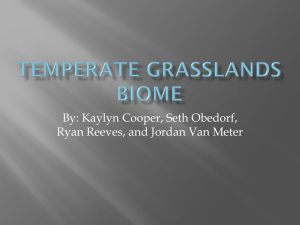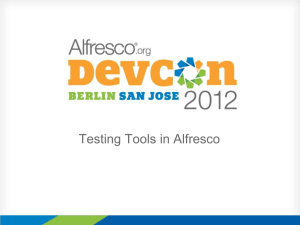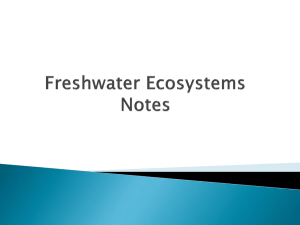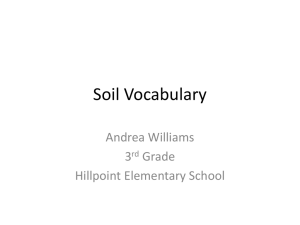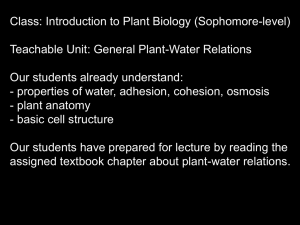PowerPoint
advertisement
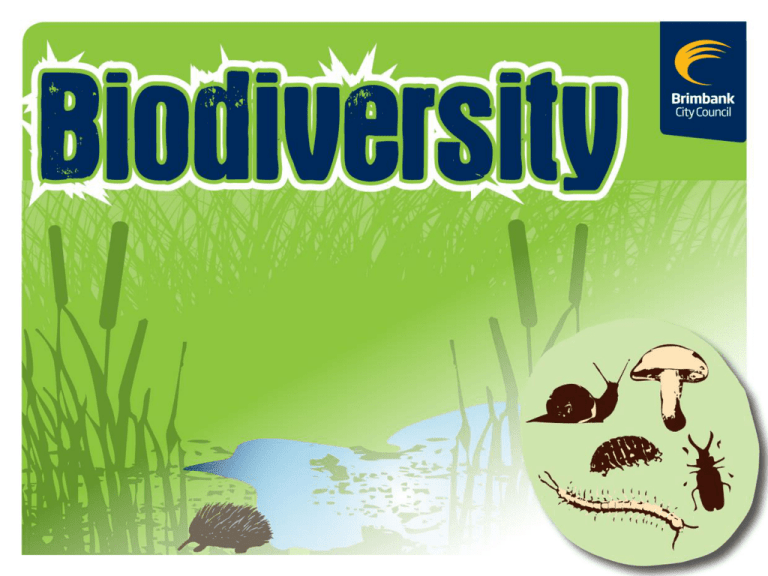
Next time you are outside, have a look around. There are lots of different types of plants around…. …some are tall …and some are small. …some are bushy There are also lots of different types of animals around…. …some are noisy …some are cute …and some are slimy. Some of the plants and animals, although the same type, look a little different. Some of this is because of where they live and what has happened to them, but some of it is in their genes. Just like some of us have brown hair, and some have blond. These River Red Gums are different shapes. These goats have different coloured coats. (These goats were running wild on the Maribyrnong River and causing lots of damage) Some areas around you will be…. …steep and dry …flat and treeless …wet and watery Snails eat plants, birds eat snails, birds live in trees, trees need water, sun and soil. We are surrounded by Biodiversity Actually - we are part of Biodiversity Different types of plants and animals Different types of landscapes Differences within types of plants and animals How was our local environment formed? 500 - 400 Million years ago Melbourne was under the ocean. Water from large mountains to the east and the west travelled down rivers into this ocean bringing with it mud and soil. This soil settled at the bottom of the ocean. 400 - 300 Million years ago underground forces caused the earth to buckle and bend. The ground beneath the ocean began to rise, and the water drained off. The mud and soil at the bottom became dry and hardened into sandstone and siltstone. How was our local environment formed? 5-1 Million years ago Volcanoes erupted in the north and west of Melbourne, spewing out runny lava. The lava filled the valleys creating a wide almost flat plain of a type of lava called ‘basalt’ This cooled and hardened into rock, called ‘basalt rock’. Bluestone is a type of basalt rock. Old volcanoes can still be seen and visited, can you name some? How was our local environment formed? Only 1 million years ago! The weather and rain broke up the basalt lava (creating soil), and streams started to form. These streams cut into the ground and formed valleys. Some valleys were shallower like the Kororoit Creek and others were deeper like the Maribyrnong River. Some areas of the basalt rock are harder than others, that is why you sometimes see escarpments or mini cliffs along the creeks. The erosion of the basalt lava is like when you see grooves in the sand at the ocean How was our local environment formed? All this activity created different landscapes around Brimbank: • Flat Plains – usually with hardly any trees, but lots of grasses and wildflowers • Steep slopes called ‘escarpments’ - with grass and sometimes trees and shrubs • Rivers and Wetlands – with water, trees, and reeds A different set of plants and animals live in each of these landscapes. These plants and animals, the landscape and the weather together form an “Ecosystem”. What is an ecosystem? All living and non-living things in a particular area and their interactions. This includes plants, animals, weather and soil type. Australia is made of hundreds of general ecosystems. In each general ecosystem there are many more smaller, specific ecosystems. The general broad ecosystems found in Brimbank 1. Grassland ecosystems 2. Escarpment shrublands 3. Riparian (River) flats Ecosystem - Grasslands We have very special grasslands in Brimbank. They are called Grasslands of the Victorian Volcanic Plain. Before European Settlement these grasslands covered much of Victoria – now there is less than 5% left! They are considered Critically Endangered which means they are in danger of extinction. Ecosystem - Grasslands • • • • Grasslands usually don’t have any trees ( sometimes there is one or two) There are many different types of grasses, but also lots of wildflowers and orchids Reptiles, mammals, birds and insects live in grasslands In the summer, sometimes the soil cracks – this is a nice cool place for reptiles and insects to retreat from the hot sun. Ecosystems - Grasslands Kangaroo Grass and Wallaby Grass Grasses may not be as big as trees, but they are just as important – they provide food for mammals like Kangaroos and Wallabies as well as insects. They provide shade and shelter for lizards and snakes. They help bind the soil together to prevent erosion. Can you imagine how dusty it would be in summer if there wasn’t any grass to protect the soil from the wind? Ecosystems - Grasslands Sunshine Orchid This beautiful orchid was thought to be extinct until some plants were found in 2000 There was once so many orchids in some areas of Brimbank that it was called “Snow in the Fields” because the white flowers looked like snow. There is now only 30 known plants in the wild, but luckily Melbourne Zoo, the Royal Botanical Gardens and others are working hard to grow the orchid from seed and plant it in the wild. Ecosystem - Grasslands Golden Sun Moth This is a special animal found in Brimbank, it is Critically Endangered. It only eats one type of grass – Wallaby Grass, only comes out in the sun and only lives for a few days as an adult (when it looks like a moth – not a caterpillar). The adult doesn’t even eat – it doesn’t have a mouth! Ecosystem - Grasslands Golden Sun Moth Ecosystem - Grasslands Striped Legless Lizard It’s not a snake – it’s a lizard! It grows to 30cm long. It has lost it’s legs through evolution, there are tiny little flaps on the body that shows it once had legs. It has a round ended tongue like ours, not a forked tongue like a snake. It lives in grasslands, because there are not many grasslands left this lizard is very rare. It squeaks when it is scared! Ecosystem – Escarpment Shrublands Escarpments are the steep slopes leading from the flat plains down into valleys. They sometimes have no trees or shrubs and sometimes have lots depending on how rocky it is, if it faces north and gets lots of sun, and how much water is available. Ecosystem – Escarpment Shrublands Wedge-tailed Eagle You can often see these huge birds soaring on the wind currents that come off the escarpment. They can have a wingspan of 2m! They make big nests in trees out of sticks and eat reptiles, birds and small mammals. Ecosystem – Escarpment Shrublands Cunningham’s Skink A skink is a type of lizard. When skinks are scared or a predator wants to eat them, they can drop their tail off! The tail wriggles around and hopefully the animal that is trying to eat the skink, eats the tail instead of the animal! The tails can grow back, but usually not as big as the first one. Ecosystem – Riparian (River) Flats These are the areas around rivers, creeks and wetlands. The soil usually has lots of nutrients (food for plants) and there is water around so this is where you will find big trees, and lots of shrubs and grasses. Around the edges of water you will find reeds which are grass like plants that grow near water. Ecosystem – Riparian (River) Flats In the water You will find algae – which is like a type of plant. This is the green slimy stuff you see in the water. Too much algae is bad, but some is good. Tadpoles and Freshwater Snails love to eat it. Ecosystem – Riparian (River) Flats Dragonfly Dragonfly eggs are laid on reeds at the waters edge. The egg hatches into a Nymph which spends it’s life in the water . It hunts other small animals in the water. As it grows it sheds it’s outer skin. They move around by squirting water out their bottom! The Nymph sheds it’s skin as it gets bigger, looking more and more like a dragonfly each time. On the last moult it crawls out of the water and emerges from it’s skin as an adult Dragonfly. Ecosystem – Riparian (River) Flats Tiger Snake This snake usually has stripes across it’s body, but not always - sometimes it is just a dark brown colour. It likes waterways and wet areas best as it’s favourite food is frogs, but it will also eat rats and mice, large insects and dead things. It’s bite is very dangerous, so if you see one - stay away. It thinks you are very dangerous, so if it sees you – it will stay away. Ecosystem – Riparian (River) Flats Growling Grass Frog The Growling Grass Frog can be brown, dull olive to bright emerald green on its back, with brown, golden, black or bronze spots or lines. It is a big frog and can grow to 10cm long, and has been known to eat small snakes! What do you think it sounds like? Ecosystem – Riparian (River) Flats Kookaburra The Laughing Kookaburra nests in open tree hollows, the babies are looked after by both parents, and will often stick around for a couple of years to help look after the next seasons babies. They eat insects, mammals, frogs and even snakes (which they will kill by dropping from a height, or bashing against a tree) Their laughing sound is not really meant to be friendly, they are telling all the other birds in the area to go away! Can you make a Kookuburra sound? Aboriginal History Aboriginal people have been known to live on these plains and valleys for over 40,000 years. The local aboriginal people are the Wurundjeri. They trapped fish, hunted birds and Kangaroos and ate one of the most diverse plant diets in the world. Fire was used as a tool to manage the land – as a way to minimise hot summer wildfires and as a method of harvesting plants and animals. This land management has shaped what species are here today. There are many signs here today of the long history of the Wurundjeri people in the local area. European Settlement Early settlers selected the plains for grazing for the new exotic animals they introduced to Australia like sheep and cows. They removed surface rocks were to make farming easier, and ploughed the land to plant crops they had brought over to Australia. These introduced crop plants, and garden plants invaded the natural ecosystems, and became weeds which competed for space and water with the indigenous plants. Introduced animals such as sheep, cows, cats, and dogs competed with or killed native animals. European Settlement Australia is riding on the sheep’s back. Sheep grazing was a major industry in farming the local area of Brimbank. The treeless grasslands of the Western plains provided a wealth of ready pastures to graze. Factories Early 1900’s saw this region of Melbourne become the industrial hub of Melbourne large chemical complexes such as Monsanto were developed. There was no Environment Protection Agency when all the chemical companies started, and there was a lot of pollution of both the creeks and the soil. Other activities that have affected our Environment Quarrying blue stone was one of the largest industries in this region, this left a series of quarry holes that were later used as tips. Surface rocks are used for landscaping taking more habitat away. Meat works along the Maribyrnong were typical of local industry that polluted the water ways – they once just used the river like a garbage disposal system….throw it in and it will be taken away! Suburbs How do we make a difference to our natural environment? • Garden plants escape (and then become weeds) • Rubbish dumping • Dog poo • Cats & Dogs • Vandalism Suburbs How do we make a difference to our natural environment ?


